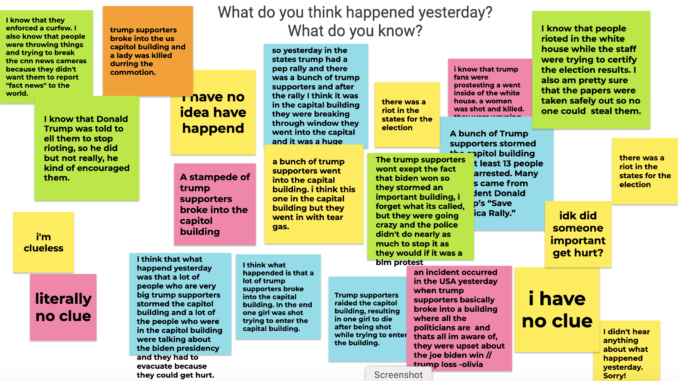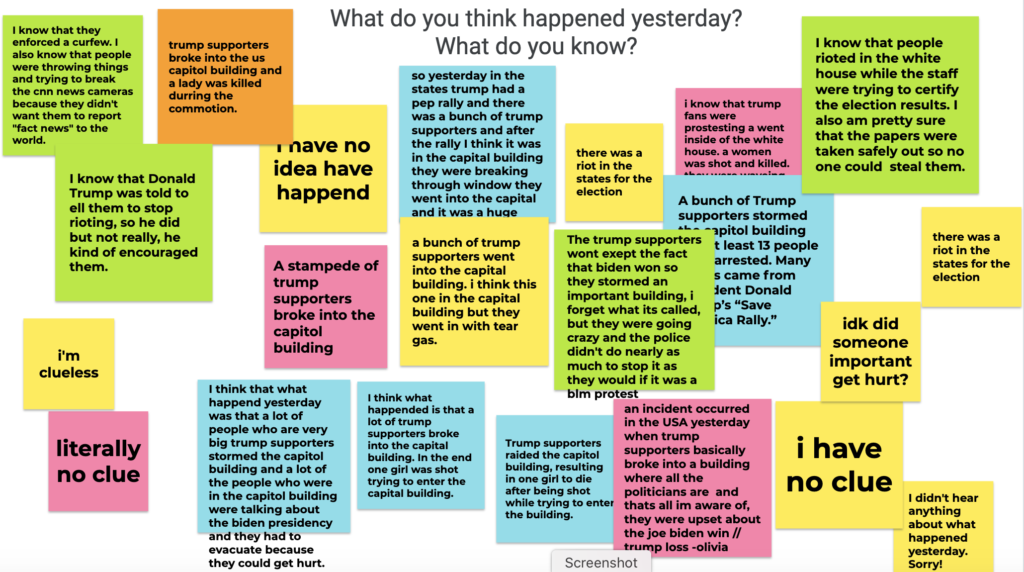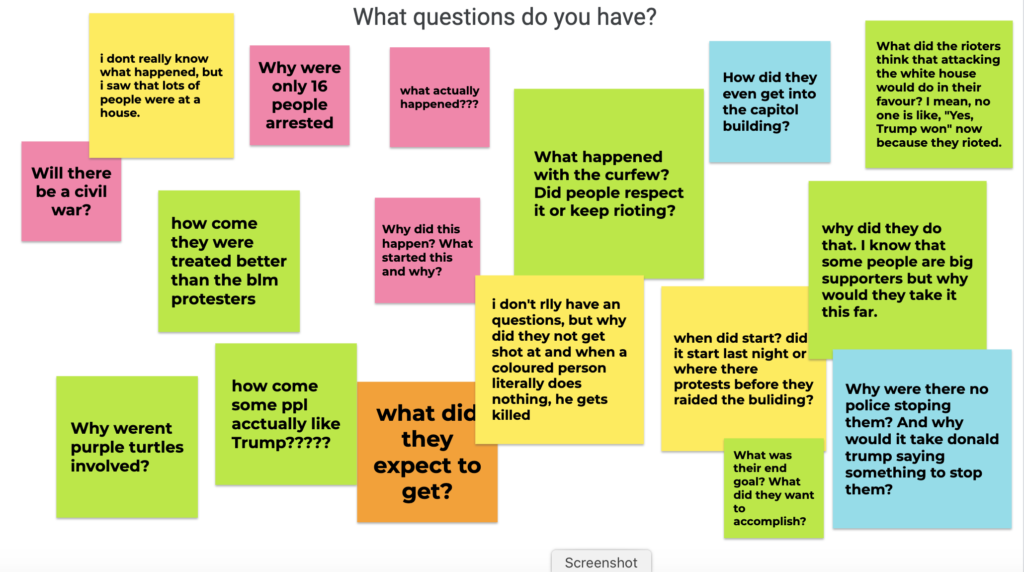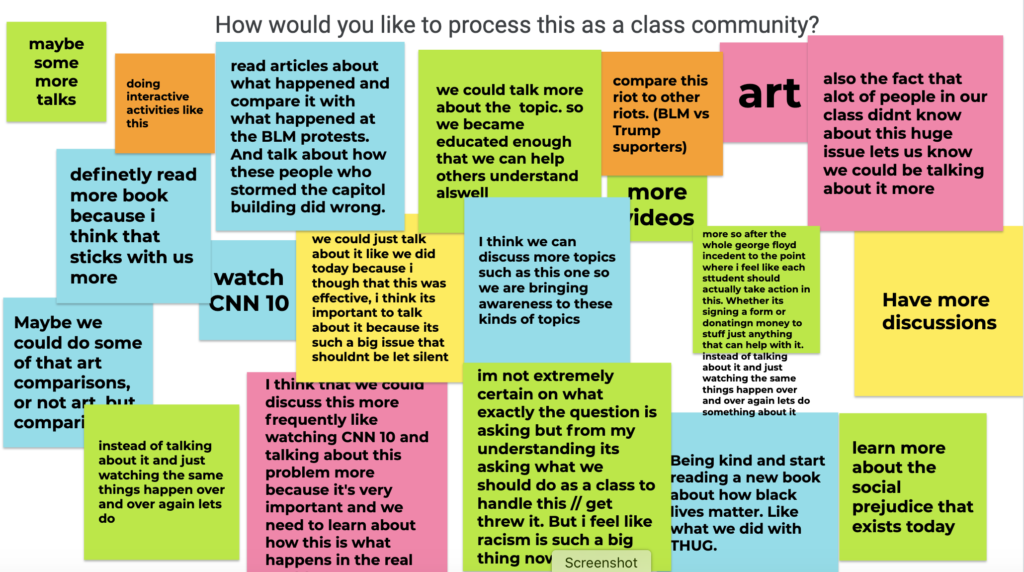
By Melissa Borysiak & Greg Harris
The ‘day after’ refers to a tragic or bizarre event that the school community, local area, or world has heard about. Washington Capitol Hill on January 6, 2021, soldier killed in Ottawa attack at Canadian National War Memorial and Parliament Hill on October 22, 2014, school shootings, deaths of classmates/educators, and so on.
Educators have a moral imperative to be aware of the world that they and their students live in AND to discuss this appropriately with their students. Many students hear bits of news, are immersed in news from their guardians, or have access to their own news feeds through social media. Others won’t have heard or seen a thing. We have to engage with our students at levels that are appropriate for them.
Students have access to news (fake, biased, true) and need their teachers to help them navigate this. This isn’t a burden placed upon teachers; this is an opportunity to value the questions and opinions of students and help them interpret events.
It is important to note, first, that there is no ‘one size fits all’ lesson plan for the ‘day after’; if you feel that an image, video, or discussion could create further harm or trauma, then don’t do it. If, in your general teaching, you never stray from the curriculum, this may not be the time to implement this action. ‘Day after’ classroom discussions aren’t meant to be a one-off event leading into the lesson of the day; these discussions may continue over time. Teachers should be consistently giving time in the school day to world events and their impact on the students.
I (Melissa) was teaching my class remotely during the storming of the United States Capitol. When I saw the news, I knew I would have to address it the next day… but how? I was still finding my footing with online teaching, and had no idea how to have a meaningful conversation with a bunch of black boxes (since I do not require my students to turn on their cameras). I turned to a friend and colleague, Sara Savoia. She had been teaching online since September and had created an online class community. Savoia developed a resource she titled “Tonight’s Events, Tomorrow’s Lesson” and shared it with me.
Establishing a PLN (Personal Learning Network) by following peers and experts on social media can find you resources when you need them most. Savoia also gave me the reassurance and confidence I needed to facilitate this discussion, reminding me that a benefit to online learning is that students can keep their reactions, feelings, and sharings anonymous.
So, what do you do in class the ‘day after’ (or even the day of, if news spreads quickly enough)?
Note: As a class we had already established community circle norms, but should an event like this happen earlier in the year, it would be important to first set these boundaries (e.g., Do not interrupt unless a comment is harmful to you; Recognize the difference between opinions and facts or clarify; Check your privilege; Listen to understand not to respond; Do not speak on behalf of a marginalized group.)

The day of: Plan for the next day; use your Personal Learning Network and search skills to find information that you may use. Consider the maturity of your class and the appropriateness of details. Your school board and administrators may have information prepared. There may be an after and/or before school staff meeting.

The day after: Acknowledge what happened.

Check student knowledge/understanding. The first thing Savoia suggested was to show a viral image of the Insurrection and ask students what they knew or thought was happening. Since I was teaching online, I collected their answers through Google’s Jamboard so that they could see all student responses in real time.

Anonymity is important whether online or in-person since students may be afraid to be wrong or embarrassed to say they don’t know what happened. Had we been in class, I would have still used a digital tool such as Jamboard or Padlet to collect responses.

Inform. Provide the information that you gathered before class. I showed a short news clip of what had happened (via CNN10; world news explained in 10 minutes for classroom use). This was necessary before moving on because several students had indicated that they didn’t know what had happened.

Ask students for their questions. This will guide your discussion.

I could see right away that some students were already aware of the comparisons being made to the Black Lives Matter protests that took place during summer 2020, and that others were projecting their opinions by asking “how come some ppl actually [sic] like Trump?????”. I could also see some fear that had to be addressed, based on the question about whether there would be a civil war. All of this informed me that they needed to be reassured that they were safe and that their outrage at the racial injustice was warranted.

Ask students what they would like to do next.

Before continuing, I needed to know how my students wanted to respond as a class community. Through this, I could see that several of them wanted to explore the day’s events through art and curriculum, specifically the racial injustice piece. Students were telling me that this could not be an isolated discussion, and if I wanted to continue being an effective educator, I had to listen. This led me to our next read aloud, BiFocal by Eric Walters & Deborah Ellis (A young adult novel about a Muslim student arrested on suspicion of terrorist affiliations). It’s important to take your students’ lead here, and mine were clearly communicating that they needed more.

Consider student discomfort or trauma and act accordingly. If students indicated that what they would like to do next is to stop having this conversation, give them an out. This may look like a ‘Breakout Room’ online, or access to a quiet space in the school. Either way, make it clear that students can be dismissed and that this is not being formally assessed.

Discuss. I brought students back to our main virtual meet to discuss what they had written and read on the Jamboards. I went through each post, one by one, and asked them if anything stood out. No specific questions, no pressure to respond. Many students zeroed in on the civil war comment, which allowed me to address their safety.

Jump back into routine. We continued until I was sure there were no more questions or comments, and then we went back to our regularly scheduled programming. Getting back to routine is important following a major event, as this enables students to engage with the flow of the class, which is comforting to many. You may need to circle back throughout the day and reassure students they are safe, now.

Debrief with other adults and your own reflections. How are you feeling? What worked well? What would you do differently? Are there guardians you need to connect with?
Of course, it’s not about what the teacher thinks of the lesson; it’s the students who will forever remember how the adults in their lives made them feel after a major event. I asked my students to reflect and comment on the ‘day after’ classroom activities:
Leah: “[…]it felt relieving to know more about what had happened, to get clarification on a few things, I felt more ready to go on with the rest of the day.”
Nara: “I also really liked how we weren’t really rushed and we took our time talking about it and it didn’t have a time period or a time table.”
Khalid: “I feel like people are more likely to share what they know on a Jamboard versus in class because there is less social pressure.”
Mayve: “[…]everyone was able to know what everyone else knew about the topic and we all learned something based off of what our classmates knew. We learned together and had a serious discussion about the topic.”
When the Day Before is Too Much for You
Sometimes, the event is beyond what you and your class can deal with on your own, especially if it is the death of a classmate. School boards have professionals who will come work with the whole school, specific classes, and individuals. You have a team of caring professionals who will help you and your students. Your school administrators will be your first contact. You aren’t alone.
While we hope you don’t have to use this, we know that odds are you will. We leave you with the words of Carl W. Buehner, “They may forget what you said, but they will never forget how you made them feel”.
Summary: Steps for Discussing the Day After
- The day of: Plan for the next day.
- The Day After: Acknowledge what happened.
- Check student knowledge/understanding.
- Inform.
- Ask students for their questions.
- Ask students what they would like to do next.
- Consider student discomfort or trauma and act accordingly.
- Discuss.
- Jump back into routine.
- Debrief with other adults and your own reflections.
References and Additional Resources
Teaching on the day after a crisis (Unconditional Learning, January 7, 2021): This opens with Be Gentle with Yourself. A quick read, reinforces discussion/responses are not about curriculum and grades; it’s about being human.
Helping kids cope with media about traumatic events (MediaSmarts, ND.): The title explains itself. Canadian and intelligent tips for working with various students’ age levels.
Teaching on the Days After: Facebook group of educators with resources and discussions. Timely. Consider this an expansion of your Personal Learning Network. (PLN) An example of a resource published Jan 6, 2021 by the founder of Teaching on the Days After.
Day After Jan 7 Slide Deck for use with Intermediate students. Created by Sara Savoia (Ardagh Bluffs PS Teacher), shared and used by Melissa Borysiak with her students. An example of how a PLN can help you get the resources you need when you need them.
PBS NewsHour Extra (PBS, 2021) Up to date materials (USA focus/bias?) to use with students. Includes videos, questions, lesson plans. You can download as Google Slides or PowerPoint, and connect to Pear Deck. Recommended for Gr 6 – 12. Similar to CNN10: 10 minutes of daily news for students. CBC Kids News may have timely updates (Canadian focus/bias?).
The Day After (Learning for Justice, 2021): This is an American response to the day after the US federal election in 2020. The framework’s subtitles suggest a pathway for discussion. Importantly, it includes the consideration for moving back to the ‘regular’ instructional day. ASIDE: Teaching Tolerance has excellent resources for extending teaching e.g., Let’s Talk: Teaching Tolerance Guide – Facilitating Critical Conversations With Students

Melissa Borysiak teaches Intermediate French Immersion at Ardagh Bluffs Public School. She has been part of the Ardagh Bluffs team since 2014, and prides herself on being a coach, leader, and ally in the school community. She, along with Greg, is part of the group of teachers that brought Phenomenon Based Learning to Ardagh. Her passions include ‘raising’ socially responsible students, facilitating organized chaos in the classroom, and collecting “aha” moments. Twitter: @MadameBor

Greg Harris instructs first year teacher candidates in Language and Classroom Management, Planning and Assessment at Lakehead University – Orillia Education. An additional mission is to inform teacher candidates how teacher-librarians and library technicians are their allies in collaboration and supporting fantastic learning opportunities for their students during their placements and throughout their teaching careers. Greg was a teacher-librarian for nearly 18 years with the Simcoe County DSB. Twitter: @LibrarianGuy